Class Echinoidea
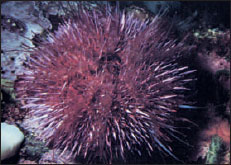 |
| Figure 23-15 Purple sea urchin Strongylocentrotus purpuratus is common along the Pacific coast of North America where there is heavy wave action. |
Class Echinoidea
Echinoids have a compact body enclosed in an endoskeletal test, or shell. Dermal ossicles, which have become closely fitting plates, make up the test. Echinoids lack arms, but their tests reflect the typical pentamerous plan of echinoderms in their five ambulacral areas. The most notable modification of the ancestral body plan is that the oral surface has expanded around to the aboral side, so that the ambulacral areas extend up to the area around the anus (periproct). The majority of living species of sea urchins are “regular”; they have a hemispherical shape, radial symmetry, and medium to long spines (Figures 23-15 and 23-16). Sand dollars (Figure 23-17) and heart urchins (Figure 23-18) are “irregular” because the orders to which they belong have become secondarily bilateral; their spines are usually very short. Regular urchins move by means of their tube feet, with some assistance from their spines, and irregular urchins move chiefly by their spines (Figure 23-17). Some echinoids are quite colorful.
Echinoids have a wide distribution in all seas, from intertidal regions to deep oceans. Regular urchins often prefer rocky or hard bottoms, whereas sand dollars and heart urchins like to burrow into a sandy substrate. Distributed along one or both coasts of North America are common genera of regular urchins (Arbacia [Gr. Arbakƒs, first king of Media], Strongylocentrotus [Gr. strongylos, round, compact, + kentron, point, spine] [Figure 23-15], and Lytechinus [Gr. lytos, dissolvable, broken, + echinos, sea urchin]) and sand dollars (Dendraster [Gr. dendron, tree, stick, + asteros, star] and Echinarachnius [Gr. echinos, sea urchin, + arachne, spider]). The West Indies- Florida region is rich in echinoderms, including echinoids, of which Diadema (Gr. diadeo, to bind around), with its long, needle-sharp spines, is a notable example (Figure 23-16D).
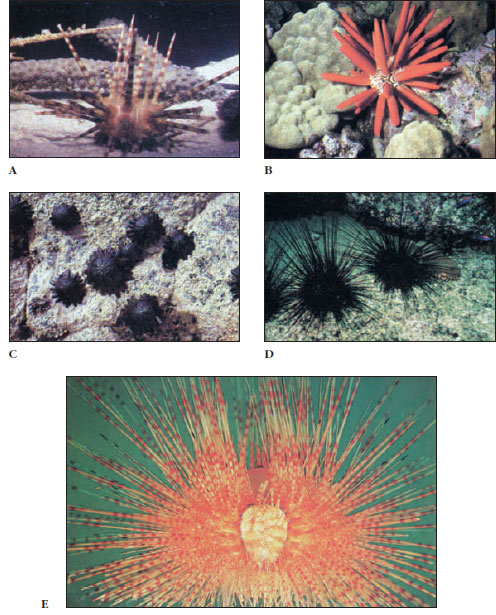 |
| Figure 23-16 Diversity among regular sea urchins (class Echinoidea). A, Pencil urchin Eucidaris tribuloides. Members of this order have many primitive characters and have survived since the Paleozoic era. They may be closest in resemblance to the common ancestor of all other extant echinoids. B, Slate-pencil urchin Heterocentrotus mammilatus. The large, triangular spines of this urchin were formerly used for writing on slates. C, Aboral spines of the intertidal urchin Colobocentrotus atratus are flattened and mushroom shaped, while the marginal spines are wedge shaped, giving the animal a streamlined form to withstand pounding surf. D, Diadema antillarum is a common species in the West Indies and Florida. E, Astropyga magnifica is one of the most spectacularly colored sea urchins, with bright-blue spots along its interambulacral areas. |
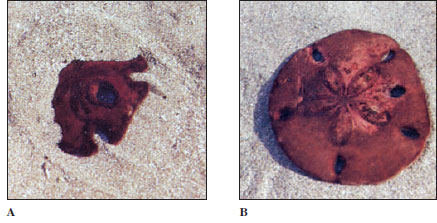 |
Figure 23-17 Two sand dollar species. A, Encope grandis as normally found burrowing near the surface on a sandy bottom. B, Removed from the sand. The short spines and petaloids on the aboral surface of this Encope micropora are easily seen. |
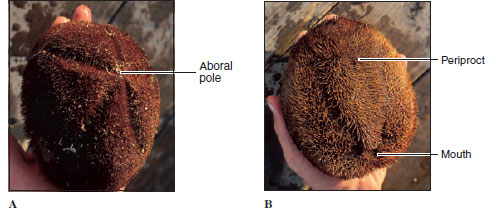 |
| Figure 23-18 An irregular echinoid Meoma, one of the largest heart urchins (test up to 18 cm). Meoma occurs in the West Indies and from the Gulf of California to the Galápagos Islands. A, Aboral view. Anterior ambulacral area is not modified as a petaloid in the heart urchins, although it is in the sand dollars. B, Oral view. Note curved mouth at anterior end and periproct at posterior end. |
Form and Function
The echinoid test is a compact skeleton of 10 double rows of plates that bear movable, stiff spines (Figure 23-19). The plates are sutured firmly. The five pairs of ambulacral rows are homologous to the five arms of sea stars and have pores (Figure 23-19B) through which long tube feet extend. The plates bear small tubercles on which the round ends of the spines articulate as ball-and-socket joints. Spines are moved by small muscles around the bases.
There are several kinds of pedicellariae, the most common of which are three jawed and are mounted on long stalks (Figure 23-4D and E). Pedicellariae help keep the body clean, especially by preventing marine larvae from settling on the body surface. Pedicellariae of many species bear poison glands, and the toxin paralyzes small prey.
Five converging teeth surround the mouth of regular urchins. In some sea urchins branched gills (modified podia) encircle the peristome. The anus, genital pores, and madreporite are located aborally in the periproct region (Figure 23-19). Sand dollars also have teeth, and the mouth is located at about the center of the oral side, but the anus has shifted to the posterior margin or even the oral side of the disc, so that an anteroposterior axis and bilateral symmetry can be recognized. Bilateral symmetry is even more accentuated in heart urchins, with the anus near the posterior on the oral side and the mouth moved away from the oral pole toward the anterior (Figure 23-18).
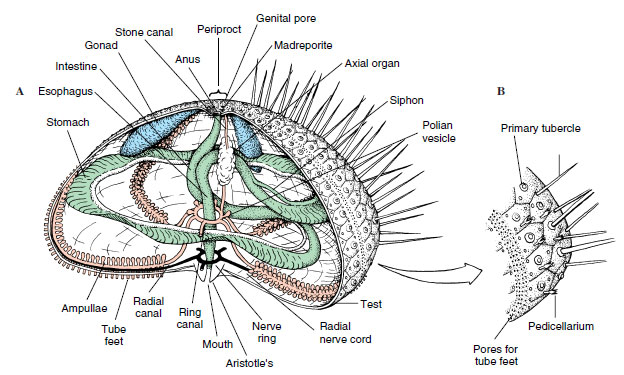 |
| Figure 23-19 A, Internal structure of a sea urchin; water-vascular system in tan. B, Detail of portion of endoskeleton. |
Inside the test (Figure 23-19) are the coiled digestive system and a complex chewing mechanism (in regular urchins and in sand dollars), called Aristotle’s lantern (Figure 23-20), to which the teeth are attached. A ciliated siphon connects the esophagus to the intestine and enables water to bypass the stomach to concentrate food for digestion in the intestine. Sea urchins eat algae and other organic material, which they graze with their teeth. Sand dollars have short club-shaped spines that move the sand and its organic contents over the aboral surface and down the sides. Fine food particles drop between the spines, and ciliated tracts on the oral side carry the particles to the mouth.
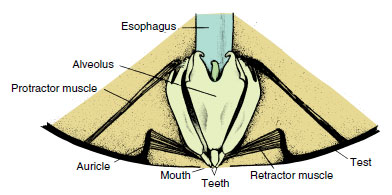 |
| Figure 23-20 Aristotle’s lantern, a complex mechanism used by the sea urchin for masticating its food. Five pairs of retractor muscles draw the lantern and teeth up into the test; five pairs of protractors push the lantern down and expose the teeth. Other muscles produce a variety of movements. Only major skeletal parts and muscles are shown in this diagram. |
Hemal and nervous systems are basically similar to those of asteroids. Ambulacral grooves are closed, and radial canals of the water-vascular system run just beneath the test, one in each of the ambulacral radii (Figure 23-19). Ampullae for the podia are within the test, and each ampulla usually communicates with its podium by two canals through pores in the ambulacral plate; consequently, such pores in the plates are in pairs. Peristomial gills, where present, are of little or no importance in respiratory gas exchange, this function being carried out principally by the other podia. In irregular urchins respiratory podia are thin walled, flattened, or lobulate and are arranged in ambulacral fields called petaloids on the aboral surface. Irregular urchins also have short, suckered, single-pored podia in the ambulacral and sometimes interambulacral areas; these podia function in food handling.
Sexes are separate, and both eggs and sperm are shed into the sea for external fertilization. Some, such as certain pencil urchins, brood their young in depressions between the spines. Echinopluteus larvae (Figure 23-10D) of nonbrooding echinoids may live a planktonic existence for several months and then metamorphose quickly into young urchins.




